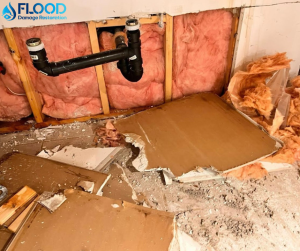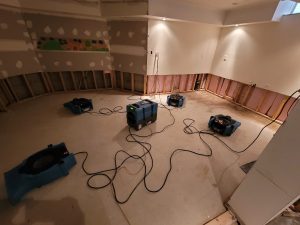Introduction
When severe weather strikes and leaves your basement flooded, it’s crucial to act quickly. While cleaning up after a basement flood may seem like a daunting task, it is possible to minimize and assess the damage effectively. In this comprehensive guide, we will walk you through the immediate steps to take when your basement floods, how to manage water removal, and how to restore your basement quickly after a flood.
Understanding Basement Floods
A flooded basement can occur due to various reasons, such as burst pipes, sudden leaks caused by accidental damage, or flooding resulting from a storm. Before we dive into the steps to mitigate the damage, it’s important to understand the causes of basement floods and how insurance coverage can play a role.
Insurance Coverage for Basement Floods
In most cases, homeowners insurance can cover water damage in your basement if it’s caused by covered events like burst pipes or sudden leaks due to accidental damage. However, it’s important to note that water damage caused by flooding resulting from a storm is typically not covered by homeowners insurance. To protect your basement from flood-related damages and have greater peace of mind, consider purchasing a separate flood insurance policy through the Flood Insurance Program.
If you have a separate flood policy it’s essential to file a claim or contact your insurance agent as soon as you notice the flooding damage. Remember, safety should always be your first priority when dealing with a flooded basement.
Immediate Steps to Take
Now that we understand the importance of insurance coverage and safety precautions, let’s delve into the immediate steps you should take when your basement floods. These steps will help minimize further damage and prevent mold development.
Step 1: Ensure Personal Safety
First and foremost, never enter a room when water is present on the floor. There may be compromised electrical wiring or standing water that could be electrified. Ensure the safety of yourself and your loved ones before proceeding.
Step 2: Turn off the Electricity
If necessary, contact a licensed electrician to disconnect the power to the basement. It’s crucial to have high-powered, battery-operated flashlights or flood lamps to navigate safely.
Step 3: Locate the Source of Flooding
Once you’ve ensured your safety, it’s important to locate the source of the flooding. Check your sump pump to see if it’s still working. Additionally, inspect walls, windows, floor cracks, pipes or hoses connected to appliances, floor drains, toilets, sinks, bathtubs, and showers for any signs of potential causes.
Step 4: Remove Waterlogged Items
To prevent further damage and mold development, remove all wet and waterlogged items from the basement. This may include flooring, such as carpet, padding, and other materials that have been impacted by the floodwater.
Step 5: Extract Remaining Water
Using a wet-dry vacuum, remove the remaining water from the basement. Focus on low-lying areas and puddles. You can also use a squeegee to move water towards floor drains or for collection by the wet-dry vacuum.
Step 6: Promote Air Circulation
After removing the water, it’s essential to promote air circulation in the basement. Contact Immediately Flood Damage Restoration for fans to dry out the area thoroughly. Additionally, turn on dehumidifiers to remove excess moisture from the air.
Drying Different Types of Flooring
The drying process for your basement’s flooring depends on the type of material it’s made of. Let’s explore the steps to dry carpeted, concrete, and wood floors after a flood.
Drying a Carpeted Floor After a Flood
When dealing with wall-to-wall carpeting after a flood, salvaging the carpeting may be possible, but the padding will likely need to be replaced. Follow these steps to dry your carpeting effectively:
- Extract Water: Use a wet-dry vacuum to remove water as much as possible from the carpeting. Consider renting a carpet cleaner to pull water and shampoo the carpet before removing it.
- Lift Carpet: Pull the carpet up from the tacking strip and tent it over chairs or ladders to promote air circulation.
- Ventilate and Dry: Position fans above and below the tented carpeting to facilitate drying. Utilize dehumidifiers to further remove moisture from the air.
- Remove Padding: Unfortunately, the padding will likely need to be discarded. Contact Flood Damage Restoration to for quote for new padding and re-installation of the dried carpeting.
- Sterilize and Deodorize: After drying the carpet and ensuring the cement pad is dry, use wood floor-friendly disinfectants to clean the floor. Properly ventilate the area during and after cleaning to prevent mold growth.
Drying a Concrete Floor After Flooding
Properly drying a concrete floor after a flood is essential to prevent cracking or failure to bond with water-based adhesives used for flooring. Here are the steps to dry a concrete basement floor effectively:
- Remove Water: Use mops, towels, or a wet-dry vacuum to remove standing water from the concrete floor.
- Promote Air Circulation: Open windows to allow air circulation in the basement. If the flooding was substantial, consider using a dehumidifier to remove excess moisture.
- Professional Assistance: If the flooding was severe, it’s recommended to hire professionals to assess the damage and provide specialized concrete drying services.
Drying a Wood Floor After Flooding
Wood floors are particularly susceptible to damage when exposed to water. To prevent discoloration or warping, follow these steps to dry a wood floor after a flood:
- Move Furniture and Wet Items: Immediately remove furniture and wet items from the wood floor to prevent further damage.
- Extract Water: Use a wet-dry vacuum to remove as much water as possible from the wood flooring. In the case of significant flooding, consider hiring a water damage restoration company for assistance.
- Disinfect the Floor: After removing standing water, clean the wood floor with a wood floor-friendly disinfectant to prevent mold growth. Ensure proper ventilation while cleaning and avoid over-saturation.
- Airflow and Dehumidification: Utilize dehumidifiers and fans to promote airflow and remove moisture from the basement. Turning on the air conditioning can also aid in drying the wood floor.
Preventing Basement Floods
While it’s crucial to know how to handle a basement flood, taking preventive measures can save you from potential future damage. Here are some steps you can take to prevent basement floods:
Repair Foundation Cracks
Regularly inspect your home’s concrete foundation, both externally and internally, for any cracks or signs of stress. Small cracks can be repaired with epoxy, but serious cracks may require professional assistance.
Clean Gutters and Downspouts
Regularly clean your gutters and downspouts to prevent rainwater from pooling and seeping into your home. Ensure that your downspouts extend at least three feet away from your home to allow water to flow freely.
Cover Window Wells
Secure your window wells with clear acrylic covers to prevent water, leaves, and debris from entering your basement through the windows. These covers also allow sunlight to enter while keeping unwanted elements out.
Maintain Your Sump Pump
Regularly inspect and maintain your sump pump to ensure it functions properly. A malfunctioning sump pump can lead to basement flooding. Consider installing a battery backup system for your sump pump to protect against power outages.
Regrade Your Lawn
Ensure that your lawn is properly graded to direct rainwater away from your home’s foundation. This can be achieved by leveling out slopes that allow rainwater to flow toward your house.
The Role of Insurance
When dealing with basement floods, it’s essential to stay connected with your insurance agent. They can provide valuable guidance on optional coverage, such as hidden water damage or sump pump failure, that may be beneficial for your situation. In the event of a flood, your insurance agent will be there to help you file a claim and navigate through the process.
Conclusion
Dealing with a flooded basement can be overwhelming, but with the right knowledge and immediate action, you can minimize the damage and restore your basement quickly. Remember to prioritize safety, turn off the electricity, remove waterlogged items, and promote air circulation during the cleanup process. Additionally, taking preventive measures can help protect your basement from future floods. Stay informed about your insurance coverage and reach out to your agent for any necessary assistance. With these steps and precautions, you’ll be better prepared to handle a basement flood and protect your home. Contact Flood Damage Restoration Immediately for any Flooded Basement.



